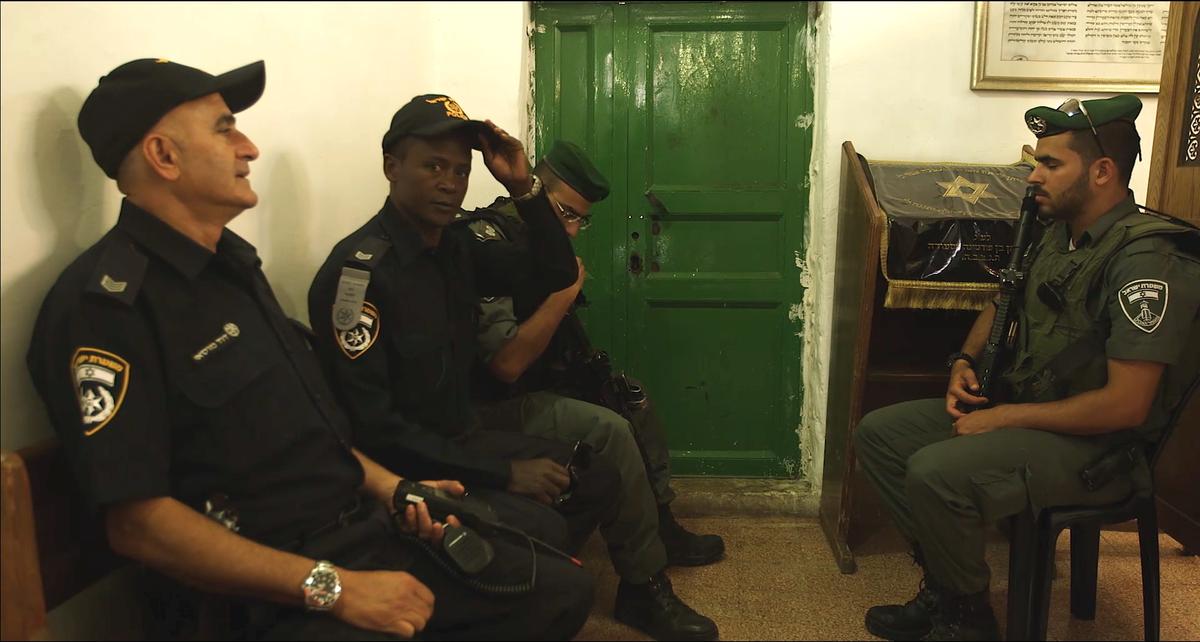ISHMAEL by Nira Pereg
Four channel video installation
10:38 min, 2015

Nira Pereg, ISHMAEL, 2015, video still, 10:38 min.
Following her iconic work ABRAHAM ABRAHAM SARAH SARAH (2012), ISHMAEL continues artist Nira Pereg’s ongoing observation of the daily routines at the Cave of the Patriarchs in Hebron, also called Ibrahimi Mosque / الحرم الإبراهيمي.
The Cave of the Patriarchs is located in the heart of the West Bank, and is considered a sacred place for both Jewish and Muslim faiths. The site has been physically divided between Muslims and Jews since the 1994 massacre of Palestinian worshipers at the Cave by a Jewish Settler. Today, 80 percent of the Cave functions as a mosque, and 20 percent functions as a synagogue. The Israeli Defense Forces (IDF) oversee the single doorway that connects these two separate spaces.
Traditionally, the Muslim call for prayer is done from the mosque’s Minaret Tower. However, due to the forced architectural division of the Cave, the mosque’s Minaret remains on the Jewish side, creating a peculiar daily routine for worshipers of both faiths that is unique to this location. The four channel video installation, ISHMAEL, documents the Muezzin’s journey through the Cave as he performs the Islamic call to worship (adhān), which is recited at five prescribed times throughout the day.
The film opens with the Muezzin waiting for Israeli soldiers to meet him at the dividing door and escort him through the Jewish side. The escort ends at a green door, and from there, the Muezzin opens the door and locks it behind him. He settles, prepares, and then calls the adhān using an amplifying sound system that echoes his prayer reaching the Cave and beyond. Throughout the scene, Israeli soldiers guard the door, and, once the prayer is over, they escort the Muezzin back to the mosque. The work is filmed in a way that supports this narrative by positioning three cameras throughout the Cave – in the mosque, at the dividing door, and in the synagogue.
Responding to the demands of Jewish Settlers living in Hebron, Israeli Border Police forbids the 7:30pm Muslim call for prayer–the Maghrib (صلاة المغرب sunset call). Instead, a Jewish Hazzan calls for the evening prayer–Mincha (before sunset)--at the synagogue. This is the only place in the world where a Jewish call to prayer is enacted publicly. Cinematically juxtaposing the calls for prayer of each faith, Pereg articulates the surreal rituals that help maintain a fragile status quo in the cave.
ISHMAEL emphasizes the performative qualities of daily activities on site, touching on the connections between ceremony and territory, and revealing a reality that is kept far from the general public’s perception and awareness.
Nira Pereg’s work examines different types of public spaces, such as vertical burial sites (KEPT ALIVE, 2010), roadblocks in Jewish Orthodox neighborhoods during the Sabbath (SABBATH 2008, 2008), or the upkeep of the Church of the Holy Sepulchre (THE RIGHT TO CLEAN, 2015). In her practice, she attends to varying aspects of the regular maintenance in these places, focusing on what she calls, spiritual bureaucracy. Her works reveal the form through which religion marks concrete territories in order to maintain itself. Pereg’s subjects relate to the power relations and cooperative arrangements that serve to strengthen the religious narrative in each site, thus raising questions about the metaphysical and physical ties created in these types of ritualistic unions.
ARTIST BIO
Over the past 20 years, Nira Pereg has created a body of work that explores the unavoidable synergy of spirit and matter, theory and practice. Her work both reveals and questions behavioral protocols, as they coexist in liminal spaces of geopolitical, religious, ideological, and ethical importance. These border zones serve as a platform for Nira’s interest and involvement in the social manifestations of power structures that influence our lives.
Nira's multichannel video installations challenge the status quo of any territory she immerses herself in. She anchors her work in documentary practice, developing her own “play of resolutions.'' Nira often employs multi-channel presentations that estrange the events from their origin and at the same time “reenact” them within the exhibition space. This particular aesthetic intervention creates a heightened sense of discomfort with “the way things are.”
Nira’s work has been exhibited worldwide at institutions including the Centre Pompidou, Paris; MoMA PS1, New York, NY; Hirshhorn Museum, Washington, DC; ZKM, Karlsruhe, Germany; Israel Museum, Jerusalem; Tel Aviv Museum of Art, Tel Aviv; National Gallery of Canada, Ottawa, Canada; Princeton University, Princeton, NJ; and TATE Modern, London.
Nira currently lives and works in Tel Aviv.www.nirapereg.net
